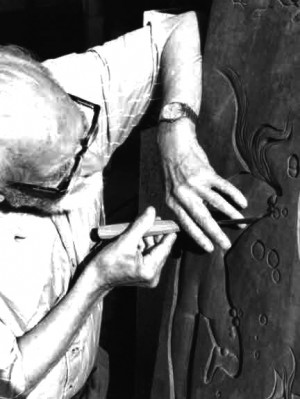1915 He was born in Felanitx on September 8, 1915 and his parents were the master mason Joan Mir and Miquela Ramis.
1923 Leaves school at the age of eight to start working with his father.
1929 Begins work at the hermitage of Sant Salvador in Felanitx on the sculptural works of the monument to ‘Crist Rei’ (Christ the King). It is there, as he himself confesses, that “my new vocation began. As I saw those men working the stone, I thought: why can't I do that?”
1933
He studies at the School of Arts and Crafts of Palma and prepares for the admission tests to the San Fernando School of Fine Arts in Madrid. 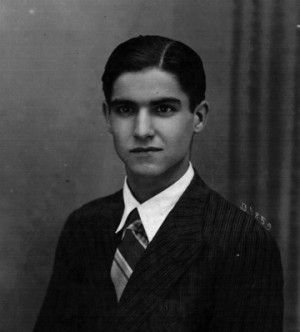
1934
He receives a scholarship from the Balearic Regional Council. In Madrid, he had Capuz and Vàzquez Díaz, among others, as teachers. He completes the ‘Balearic Slinger’ for the Balearic Regional Council. This is his first piece of work and his first slinger, a subject to which he will return in his full maturity.
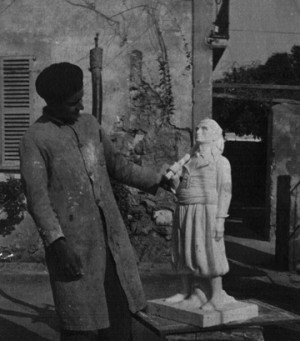
1935 He completes a bust of Mr Mateu Alzamora, as well as a bas-relief, a bust and a monument.
1937 He is appointed chair of the Felanitx Vocational Training Institute. He is also a member of the commission for the creation of the Vocational Training School of Felanitx where he was appointed drawing teacher.
1938 He completes the sculptural group ‘España rompe sus yugos’ (Spain Breaks its Yokes) for the Balearic Regional Council.
1939 He completes several sketches for the competition for the monument in honour of the warship ‘Baleares’. He completes the ‘Cruz de los caídos’ (Cross of the Fallen) in Felanitx.
1940 He receives the Madrigal End of Term Award for sculpture. He makes an obituary tribute speech for the sculptor and member of the San Fernando Royal Academy, Julio Vicente, in the Theatre of the Fine Arts Circle in Madrid, entitled ‘Padre, maestro y amigo’ (Father, Teacher and Friend). He completes the sculptural group ‘Esto es Navarra’ (This is Navarra) and founds the Arts and Culture Centre in Felanitx.
1941 He receives his degree in Fine Arts from the San Fernando School of Fine Arts in Madrid, specialising in sculpture and obtains the End-of-Course Honour Award through public competitive examination, the Madrigal Foundation Award from the San Fernando Royal Academy of Fine Arts of Madrid, the ‘Salón de Primavera’ Award and the bronze medal in drawing and engraving from the Palma Fine Arts Circle. He also receives the Aníbal Álvarez Foundation Prize, awarded by the San Fernando Royal Academy of Fine Arts in Madrid. He completes portraits of Miquel Sard, Ernesto Mestre and Bartolomé Rebassa, a monument for the ‘Colegio de la Inmaculada’ School in Palma, the sculptural group ‘Lujo y miseria’ (Luxury and Misery) and prepares a collection of typical Mallorcan topics in bas-relief.
1942
He completes a degree specialising in Medal Modelling, receiving the End-of-Course Honour award.
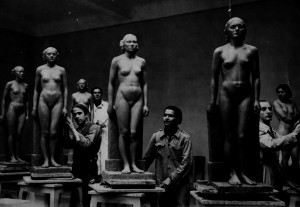
1943 He is appointed to the position of General Teacher of Modelling at the ‘Santa Isabel de Hungría’ School of Fine Arts, Seville.
1944 He completes a portrait of Dr Rigo, for the San Salvador Chapel in Felanitx and creates the piece of work, ‘Eva’, on wood.
1945 He receives the bronze medal for sculpture from the ‘IV Salón de Otoño’ of the Fine Arts Circle of Palma with a work entitled ‘Composición’ (Composition). He completes the mausoleum for the Ginard family in the cemetery in Campos and is appointed teacher of Modelling at the Arts and Crafts School in Palma.
1946 He is put forward for the first National Medal of the Fine Arts Biennale with the work ‘Ritmo’ (Rhythm). He receives the bronze medal for Sculpture from the ‘IV Salón de Otoño’ of the Fine Arts Circle of Palma with the aforementioned piece of work (currently titled ‘Deesa de Formentor’ [Goddess of Formentor]).
1947 He completes a bust of General Franco for the Balearic Regional Council’s auditorium for the Second Contest of Decorative Arts, in which he also receives a bronze medal in pottery. He receives a bronze medal in sculpture in the ‘Salón de Otoño’ of the Fine Arts Circle of Palma, first prize in the International Sculpture Contest of the Marian Year and is the winner of the Bishop Campins Portraits Contest. He completes the statue of Ramon Llull in Llubí.
1949 He passes the public competitive examination in the first position, granting him a post as teacher of Modelling and Casting at the Arts and Crafts School of Palma, where he worked until his retirement. He completes a monument to Bishop Campins for the city of Porreres, a mausoleum for the Magí Marquès family in the cemetery of Inca, a mausoleum for the Tejedor family in the cemetery of Felanitx and a stone monument to Dr Manuel Salas for the Psychiatric Hospital of Palma. He receives the End-of-Course Honour Award from the San Fernando Fine Arts School of Madrid.
1950 He is granted the Medal of the City of Felanitx and is appointed member of the Royal Academy of Fine Arts and Historical Sciences of Toledo. He completes four relief pieces and seven statues for the Hotel Bahia Palace in Palma, a relief for the facade of the San Francesc School in Palma and a relief entitled ‘El trabajo’ (The Work) for the Salas family palace in Palma.
1951 He completes a group of five monumental reliefs in metal and stone about the life of Saint Francis of Assisi, and a Saint Francis in alabaster, for the San Francesc School in Palma and a monument to Adan Diehl for the Hotel Formentor. In the V Crafts Fair, he exhibits a work entitled ‘Jacent’ (Lying), ‘Ramon Llull’ and sketches of the reliefs of Saint Francis.
1952 He completes monuments for the Son Sant Joan Military Base of Palma: ‘Conseguida la aspiración a volar’ (Achieved the Dream of Flying), ‘Al personal de tierra’ (To the Ground Staff) and ‘Ansias de Libertad’ (Yearning for Freedom), now entitled ‘Ícar’ (Icarus). He also completes two reliefs in the shape of monoliths, ‘Ramon Llull’ and ‘Fra Juníper Serra’, for the auditorium of San Francesc School of Palma, an Easter procession float ‘El santo entierro’ (The Holy Burial) for the Seraphic Youth Brotherhood of Palma, a monument to the ‘City of Palma’, commissioned by the council and a 14-metre façade for the Franciscan Church on the Avenida Meridiana, Barcelona, entitled ‘El canto a la vida’ (Hymn to Life). Monument to the "City of Palma", commissioned by the government. Facade for the Franciscan Church of Avenida Meridiana, Barcelona, called “El canto a la vida” ("Hymn to life") of 14 meters.
1953 He creates an Easter procession float of polychromatic wood, ‘Entrada de Jesús en Jerusalem’ (Jesus’ Entry into Jerusalem) for the Brotherhood of Santiago in the San Jaume Church of Palma.
1954 He completes a monument to Archduke Luís Salvador for the city of Palma, a monument to the Immaculate Conception for the city hall of Felanitx and an Easter procession float of polychromatic wood (The Holy Burial) for the Teatina Youth Brotherhood of Felanitx.
1955 He completes a monument to Sister Francinaina Cirer for the city hall of Sencelles.
1956 He is appointed member of the San Fernando Royal Academy of Fine Arts of Madrid and completes a sculpture of Lluís Vives for the Lluís Vives School in Palma.
1957 He receives the ‘First Medal for Sculpture’ from the ‘Salón de Otoño’ of the Fines Arts Circle of Palma and completes a portrait of Mr Josep Balaguer for the Fine Arts Circle of Palma.
1958 He receives the Honour Medal from the ‘Salón de Otoño’ of the Fine Arts Circle of Palma.
1959
He completes a mausoleum for the Balaguer family in the cemetery of Palma.
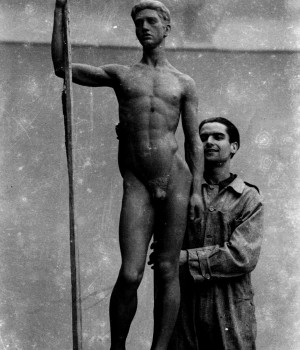
1960 He obtains, through public competitive examination, a post as drawing teacher at Ramon Llull High School in Palma. He completes a mausoleum in the cemetery of Llucmajor and an Easter procession float on polychromatic wood ‘La Madre de Dios de los Dolores’ (Virgin of Sorrows) for the Macarena Brotherhood of Felanitx.
1962 He completes a sculptural group for the Lluc monastery ‘La Cantoría’ in alabaster; the base for the Virgin is composed of four angels and four candelabra, each of them in the form of an altar boy.
1964 He creates the Easter procession floats ‘El Santo Entierro’ (The Holy Burial) and ‘La Virgen y San Pedro’ (The Virgin and Saint Peter) for the Seraphic Youth Brotherhood of Palma.
1966
He completes a statue of Saint Francis for the monastery of Randa.
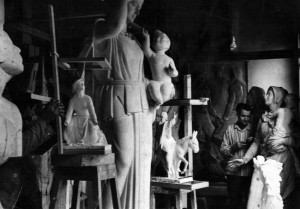
1967 He is appointed member of the Sant Sebastià Royal Academy of Fine Arts in Palma.
1968 He completes an altar and tabernacle of bronze and statues and reliefs in wood of 'Saint Francic and the Virgin Mary for the ‘La Porciúcula’ Church in Arenal, Palma.
1971 He is appointed director of the Arts and Crafts School of Palma. For ten to twelve years he practically abandons sculpture and dedicates all his time to teaching and to the direction of the School, which in this period went from having 10 to having 40 teachers and from 200 to 2000 students; the number of specialty subject areas increased to 13.
1972 He receives the City of Palma Award and completes a monument to Guillem Sagrera.
1974
Under his direction, the specialty subjects of Photography and Enamels are created at the Arts and Crafts School. Painting lessons with live models started being given.
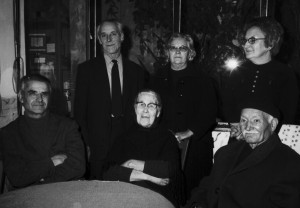
1977 He creates the specialty subject of Restoration at the Arts and Crafts School.
1978 He is the victim of a kidnapping, but he manages to escape from his captors. This event represents a turning point in his life: from that moment on, he adopted a new approach which had a positive effect on his work.
1979 For the second time, he is awarded the City of Palma’s ‘Premio Extraordinario’ (Extraordinary Award) for sculpture for the work ‘Feinejant’ (Working).
1980 He completes the 230-cm bronze monument to Guillem Segrera to be placed beside the Lonja in Palma.
1982 He completes a Christ, altar and tabernacle with seven bronze figures for the school ‘Colegio de la Montaña de Santa Cruz’ in Tenerife.
1983 He is appointed member of the ‘Santa Isabel de Hungría’ Royal Academy of Fine Arts of Seville.
1984
He starts studying the prehistory of the Balearic Islands and chooses the slinger as its most symbolic figure. He completes the first sketches. It is the beginning of a new period, with regard to both subject matter and style and technique. He begins what he calls the ‘study of the emblematic characters of Mallorca’.
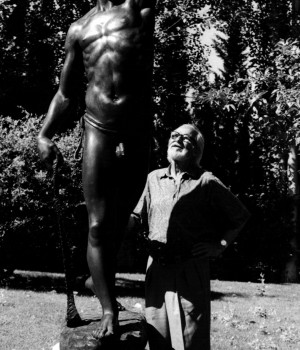
1985 At this time, he almost goes blind. He has an unfortunate operation and comes to believe that he will not see again but he recovers and is like a phoenix emerging from the ashes: he begins one of the most productive and creative periods of his life as a sculptor. He completes a great number of Balearic slingers in different positions, sizes, materials and techniques. He also creates four reliefs on this topic: ‘La Família’ (The Family), ‘La Caça’ (The Hunt), ‘La Defensa de les Llibertats’ (‘The Defense of the Freedoms’) and ‘La construcció del Talaiot’ (The Building of the Talaiot).
1986 He completes an altar and tabernacle, with seven bronze figures, for the Church of the Franciscans of Texas (USA).
1988 He completes the ‘La Balanguera’ sculptural group with four figures who emerge from a block of 3.5 metres. He participates in a collective exhibition at the Felanitx House of Culture with three slingers and the sculptural group ‘Feinejant’ (Working).
1989 He completes a 2.5-metre relief of slingers, entitled ‘La Família’ (The Family), for Sa Nostra Cultural Centre of Palma.
1990 He gives the inaugural address on the occasion of Josep Mascaró Pasarius’ admission to the Sant Sebastià Fine Arts Academy. The gymnast ‘El Salt de l’Àngel’ (The Spring of the Angel) is completed in silver for the jeweller’s guild award.
1991
He holds an individual exhibition at the Felanitx House of Culture.
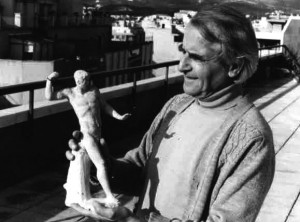
1992 He is granted the gold medal by the Fine Arts Circle of Palma, the institution’s highest honour. As a result, he holds an individual exhibition, sponsored by the city councils of Palma and Felanitx. He gives the inaugural address on the occasion of sculptor Remígia Caubet González’s admission to the Sant Sebastià Fine Arts Academy. He is awarded the Arts and Humanities Prize 91/92 granted by the Rotary Club of Mallorca. He participates in the Expo 92 in Seville. He is the only living artist who has a work in the permanent collection of this exhibition, with a life-sized slinger made of wood, the reliefs of ‘La Caça’ (The Hunt), the ‘Defensa de les llibertats’ (Defense of the liberties) and three smaller slingers, presented in the Balearic Islands pavilion.
1993 The ‘Bartolomé March Servera’ Foundation acquires a slinger for the Sculpture Museum of Cala Ratjada. The City Council of Palma donates one of Jaume Mir’s slingers to the Sports Museum of Lausanne in Switzerland, on the occasion of the concession of the Universiada 99 to Palma. He participates in the collective exhibition ‘Per amor a l'Art’ (For the Love of Art) with the work ‘Ícar’ (Icarus), which was placed in the Plaza Mayor. The controversy regarding nudity resurfaces and an arm of the aforementioned statue is ripped off. He begins the study for the portrait of the hermits, producing several drawings and a small relief.
1994
The newspaper Última Hora and the ‘Grupo Serra’ grants him the ‘Silver Siurell’ as the Majorcan of the Year.
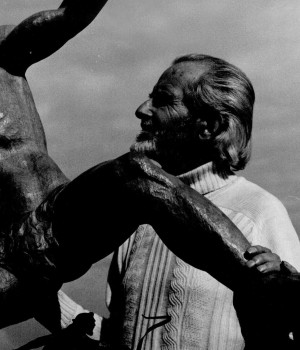
1995 The Balearic Parliament acquires a slinger to install in the hall. It also acquires a small version of the same slinger, of which 70 copies are created and given to all the parliamentarians who finish the term in office that year. Pere Serra acquires the bronze ‘Ícar’ (Icarus) in order to install it in the garden of his home in the valley Soller. Mir holds an exhibition in the gardens of the Hotel Formentor on the occasion of the Summit of the European Heads of State.
1996 The University of the Balearic Islands acquires the slinger ‘Vigía’ (Guard). The Balearic Parliament commissions him to design the medal for the fourth term in office, using the theme of the Balearic slinger. He completes the bronze statue of Ramon Llull for the Balearic Parliament’s new building.A small version of the same piece has been copied as a present for distinguished visitors. The ‘Grupo Serra’ and the Palma City Council commissions him to make a monument to the historian, Josep Mascaró Pasarius. He completes a table altar and a tabernacle with seven figures for the Franciscan school in Puerto Rico.
1997 He gives the inaugural address on the occasion of Pere A. Serra Bauzà’s admission to the Sant Sebastià Fine Arts Academy of Palma.
1998
He holds an exhibition in the Lonja of Palma, organised by the Balearic Government, receiving more than 30,000 visitors. The Balearic Government awards him the Ramon Llull Prize.
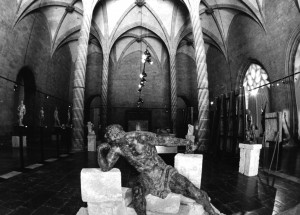
1999 He completes a bronze monument of the ‘Trencadors de Marès’ (Stonemasons) in Muro. The Palma City Council acquires the sculpture, ‘Atletes’ (Athletes), on the occasion of the ‘Universiada’, which is installed at the entrance of the stadium Son Moix in Palma. The sketch of the work ‘Atletes’ (Athletes) was copied by the City Council of Palma as a gift for distinguished visitors. He gives the inaugural address on the occasion of the painter Joan Bennàssar’s (a former pupil of Mir’s) admission to the Sant Sebastià Royal Academy of Palma. The book ‘Els Foners Balears’ (The Balearic Slingers), edited by the ‘Grup Serra’ is illustrated by Mir with drawings of slingers, plus a lithography, also on the topic of the slingers. He completes a sketch for the figure of the Republican bomber Antoni Coll and a drawing of the ‘Trencador de Pedra’ (Stonemason), to illustrate the special Christmas issue of the newspaper Última Hora. He completes a monument to Joanot Colom, for the neighbourhood of Son Gotleu in Palma. The Island Council of Mallorca acquires a small version of ‘La Balanguera’ for distinguished visitors.
2000 He completes the portraits of Josep Mascaró Pasarius, Blai Bonet, Pere A. Serra Bauzà, Nadal Batle, Miquel Àngel Riera, Xesc Forteza, Felicià Fuster and Baltasar Pocel. He completes a monument to Cervantes in Naupactos (Lepanto), Greece and is granted the city medal of Naupactos. The City Council of Alaró acquires the work ‘Ícar’ (Icarus). Mir organises an exhibition in Pollença with the figure of Nuredduna as the central theme and participates in the exhibition ‘Per amor a l’Art’ (For the Love of Art) with the work ‘Joanot Colom’.
2001
The executive committee of the PSIB of Mallorca acquires a female figure in order to commemorate the ‘Day of the Working Woman’. He completes the ‘La Benvinguda’ (The Welcome) bronze monument in homage to the hospitality workers.
